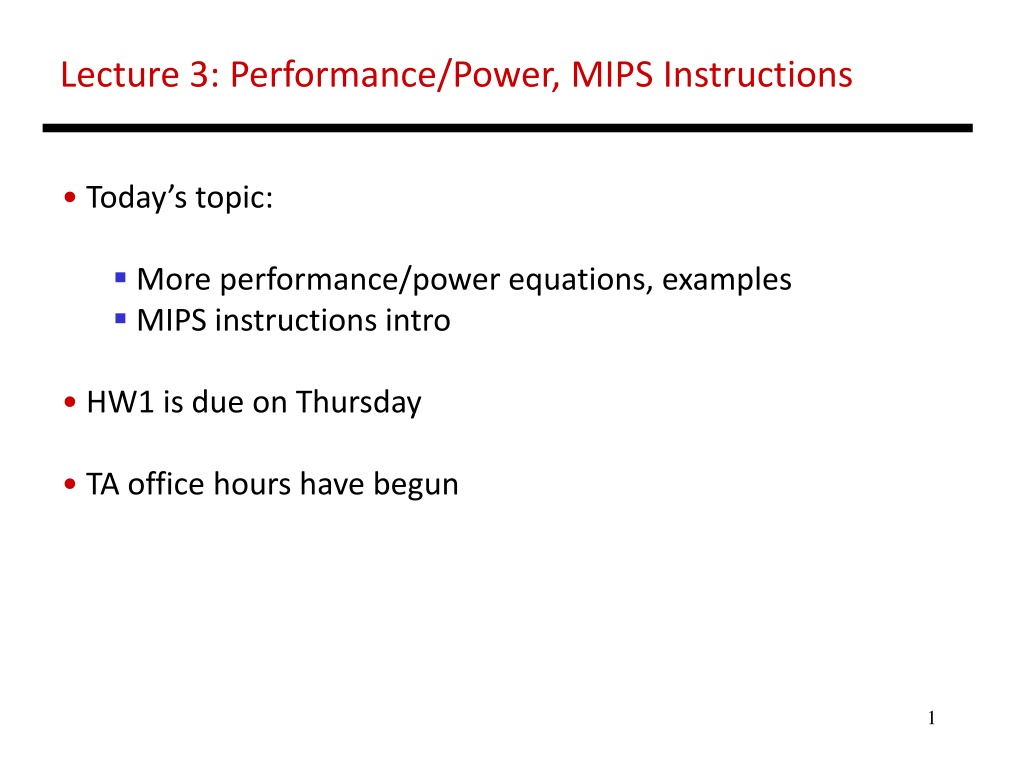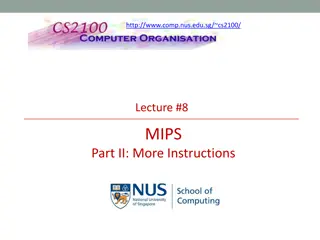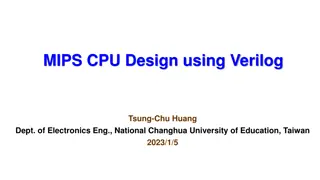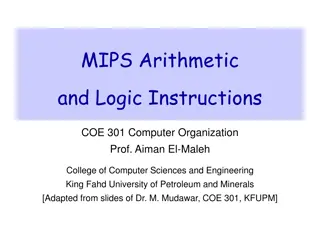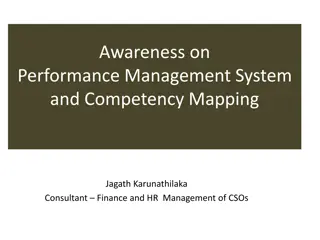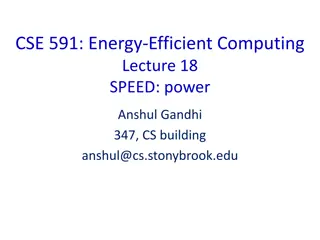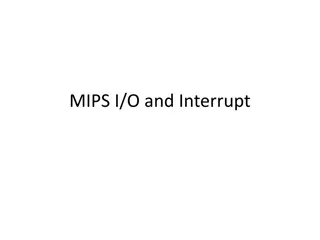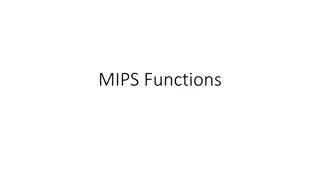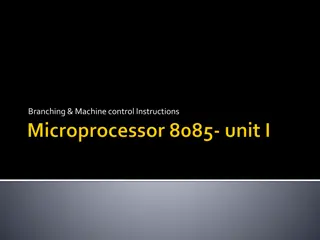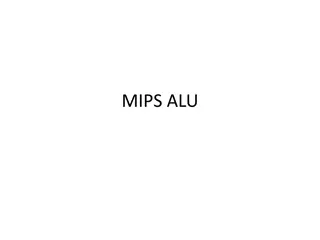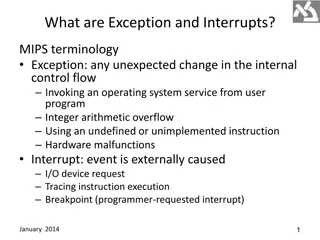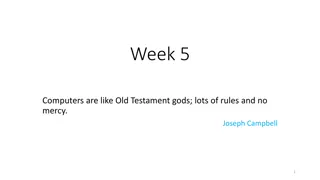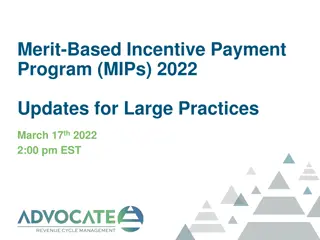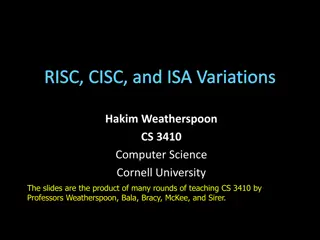Lecture 3: Performance/Power, MIPS Instructions
In this lecture, we delve into performance and power equations, offering examples and an introduction to MIPS instructions. The focus is on understanding the relationship between performance and power in computing systems. A reminder that HW1 is due on Thursday, and TA office hours have begun. Stay tuned to enhance your knowledge in this area!
Download Presentation

Please find below an Image/Link to download the presentation.
The content on the website is provided AS IS for your information and personal use only. It may not be sold, licensed, or shared on other websites without obtaining consent from the author.If you encounter any issues during the download, it is possible that the publisher has removed the file from their server.
You are allowed to download the files provided on this website for personal or commercial use, subject to the condition that they are used lawfully. All files are the property of their respective owners.
The content on the website is provided AS IS for your information and personal use only. It may not be sold, licensed, or shared on other websites without obtaining consent from the author.
E N D
Presentation Transcript
Lecture 3: Performance/Power, MIPS Instructions Today s topic: More performance/power equations, examples MIPS instructions intro HW1 is due on Thursday TA office hours have begun 1
Performance Equation - I CPU execution time = CPU clock cycles x Clock cycle time Clock cycle time = 1 / Clock speed If a processor has a frequency of 3 GHz, the clock ticks 3 billion times in a second as we ll soon see, with each clock tick, one or more/less instructions may complete If a program runs for 10 seconds on a 3 GHz processor, how many clock cycles did it run for? If a program runs for 2 billion clock cycles on a 1.5 GHz processor, what is the execution time in seconds? 2
Performance Equation - II CPU clock cycles = number of instrs x avg clock cycles per instruction (CPI) Substituting in previous equation, Execution time = clock cycle time x number of instrs x avg CPI If a 2 GHz processor graduates an instruction every third cycle, how many instructions are there in a program that runs for 10 seconds? 3
Factors Influencing Performance Execution time = clock cycle time x number of instrs x avg CPI Clock cycle time: manufacturing process (how fast is each transistor), how much work gets done in each pipeline stage (more on this later) Number of instrs: the quality of the compiler and the instruction set architecture CPI: the nature of each instruction and the quality of the architecture implementation 4
Example Execution time = clock cycle time x number of instrs x avg CPI Which of the following two systems is better? A program is converted into 4 billion MIPS instructions by a compiler ; the MIPS processor is implemented such that each instruction completes in an average of 1.5 cycles and the clock speed is 1 GHz The same program is converted into 2 billion x86 instructions; the x86 processor is implemented such that each instruction completes in an average of 6 cycles and the clock speed is 1.5 GHz 5
Power and Energy Total power = dynamic power + leakage power Dynamic power activity x capacitance x voltage2 x frequency Leakage power voltage Energy = power x time (joules) (watts) (sec) 6
Example Problem A 1 GHz processor takes 100 seconds to execute a program, while consuming 70 W of dynamic power and 30 W of leakage power. Does the program consume less energy in Turbo boost mode when the frequency is increased to 1.2 GHz? 7
Example Problem A 1 GHz processor takes 100 seconds to execute a program, while consuming 70 W of dynamic power and 30 W of leakage power. Does the program consume less energy in Turbo boost mode when the frequency is increased to 1.2 GHz? Normal mode energy = 100 W x 100 s = 10,000 J Turbo mode energy = (70 x 1.2 + 30) x 100/1.2 = 9,500 J Note: Frequency only impacts dynamic power, not leakage power. We assume that the program s CPI is unchanged when frequency is changed, i.e., exec time varies linearly with cycle time. 8
Benchmark Suites Each vendor announces a SPEC rating for their system a measure of execution time for a fixed collection of programs is a function of a specific CPU, memory system, IO system, operating system, compiler enables easy comparison of different systems The key is coming up with a collection of relevant programs 9
SPEC CPU SPEC: System Performance Evaluation Corporation, an industry consortium that creates a collection of relevant programs SPEC 2006 includes 12 integer and 17 floating-point applications The SPEC rating specifies how much faster a system is, compared to a baseline machine a system with SPEC rating 600 is 1.5 times faster than a system with SPEC rating 400 Note that this rating incorporates the behavior of all 29 programs this may not necessarily predict performance for your favorite program! Latest version: SPEC 2017 10
Deriving a Single Performance Number How is the performance of 29 different apps compressed into a single performance number? SPEC uses geometric mean (GM) the execution time of each program is multiplied and the Nth root is derived Another popular metric is arithmetic mean (AM) the average of each program s execution time Weighted arithmetic mean the execution times of some programs are weighted to balance priorities 11
Amdahls Law Architecture design is very bottleneck-driven make the common case fast, do not waste resources on a component that has little impact on overall performance/power Amdahl s Law: performance improvements through an enhancement is limited by the fraction of time the enhancement comes into play Example: a web server spends 40% of time in the CPU and 60% of time doing I/O a new processor that is ten times faster results in a 36% reduction in execution time (speedup of 1.56) Amdahl s Law states that maximum execution time reduction is 40% (max speedup of 1.66) 12
Common Principles Amdahl s Law Energy: performance improvements typically also result in energy improvements less leakage 90-10 rule: 10% of the program accounts for 90% of execution time Principle of locality: the same data/code will be used again (temporal locality), nearby data/code will be touched next (spatial locality) 13
Recap Knowledge of hardware improves software quality: compilers, OS, threaded programs, memory management Important trends: growing transistors, move to multi-core and accelerators, slowing rate of performance improvement, power/thermal constraints, long memory/disk latencies Reasoning about performance: clock speeds, CPI, benchmark suites, performance and power equations Next: assembly instructions 14
Instruction Set Understanding the language of the hardware is key to understanding the hardware/software interface A program (in say, C) is compiled into an executable that is composed of machine instructions this executable must also run on future machines for example, each Intel processor reads in the same x86 instructions, but each processor handles instructions differently Java programs are converted into portable bytecode that is converted into machine instructions during execution (just-in-time compilation) What are important design principles when defining the instruction set architecture (ISA)? 15
Instruction Set Important design principles when defining the instruction set architecture (ISA): keep the hardware simple the chip must only implement basic primitives and run fast keep the instructions regular simplifies the decoding/scheduling of instructions We will later discuss RISC vs CISC 16
A Basic MIPS Instruction C code: a = b + c ; Assembly code: (human-friendly machine instructions) add a, b, c # a is the sum of b and c Machine code: (hardware-friendly machine instructions) 00000010001100100100000000100000 Translate the following C code into assembly code: a = b + c + d + e; 17
Example C code a = b + c + d + e; translates into the following assembly code: add a, b, c add a, b, c add a, a, d or add f, d, e add a, a, e add a, a, f Instructions are simple: fixed number of operands (unlike C) A single line of C code is converted into multiple lines of assembly code Some sequences are better than others the second sequence needs one more (temporary) variable f 18
